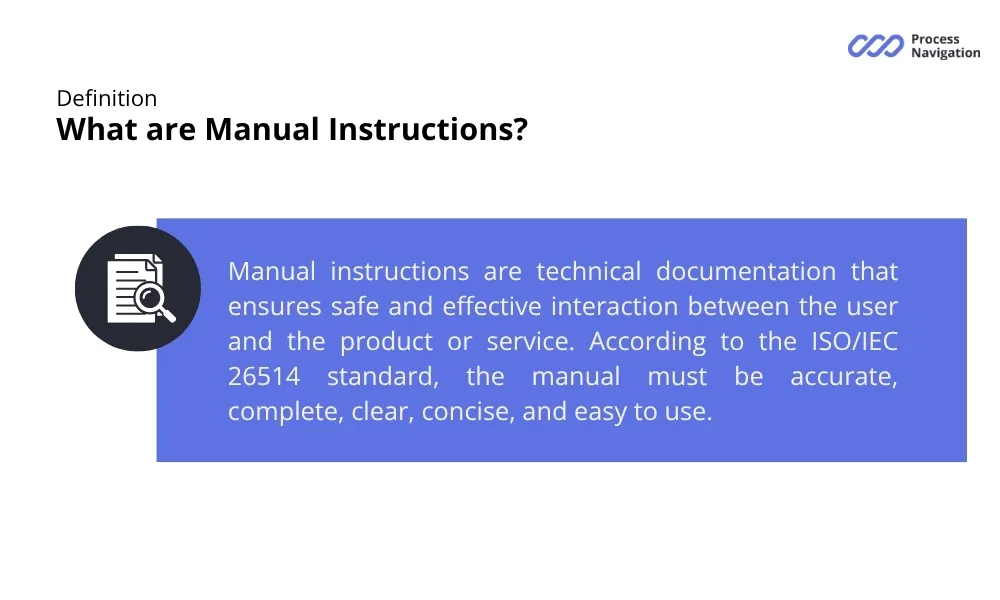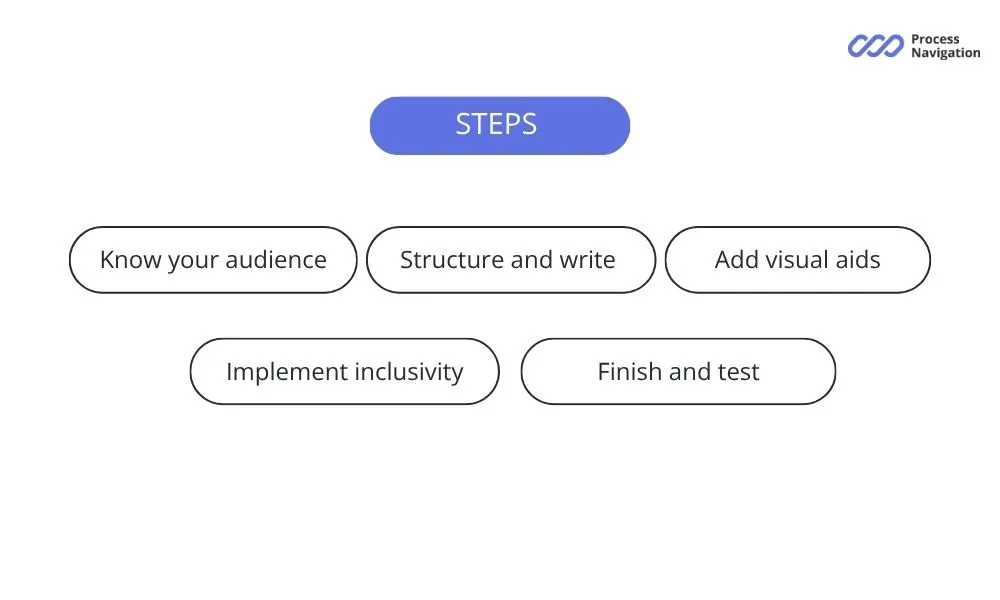In the era of digital transformation, high-quality instruction manuals and user manuals have become a critically important success factor for any product. Companies with professional instruction manuals receive 30% fewer support requests and increase customer satisfaction. Creating a comprehensive instruction manual is not only a technical requirement but also a strategic advantage.
This guide represents a practical toolkit for creating instruction manuals and writing user instruction manuals that truly work in modern business. It provides guidance on step by step instructions, visual aids, and interactive instruction manuals to enable users to achieve success.
What Makes an Effective User Manual and Why is It Needed?
An instruction manual is a structured document containing step-by-step instructions on how to use, configure, maintain, and troubleshoot a product. Manual instructions are technical documentation that ensures safe and effective interaction between the user and the product or service. According to the ISO/IEC 26514 standard, the manual must be accurate, complete, clear, concise, and easy to use.
It is a comprehensive document that includes:
- Descriptive section — product characteristics and capabilities.
- Procedural section — sequence of user actions.
- Reference section — technical data and specifications.
- Diagnostic section — troubleshooting and problem solving.
- Regulatory section — safety requirements and compliance with standards.
An effective instruction manual is more than just a description of product features. It is:
- Strategic tool for reducing operational costs.
- Marketing asset for demonstrating professionalism.
- Legal protection against potential claims.
- Feedback channel with user feedback.
High-quality user manuals and helpful instruction manuals can assist users in following clear instructions, maintaining user safety, and improving user satisfaction.
Classification of User Guides
Instruction manuals, installation manuals, and training manuals are classified based on purpose, target audience, and features. Proper step-by-step guide creation ensures that both new and experienced users understand essential elements and key features.
| Instruction type | Purpose | Audience | Features |
| Quick Start Guide | Quick start | New users | 1-2 pages, main features |
| User Manual | Complete guide | All users | Detailed description of all features |
| Assembly Instructions | Assembly/installation | End users | Step-by-step visualization of the process |
| Technical Manual | Maintenance | Specialists | Procedures and product details |
| Safety Instructions | Security | All users | Warnings and precautions |
Advantages of High-quality Instructions for Business
- Business scaling. A high-quality simple instruction manual allows you to quickly bring products to new markets without additional investment in local support.
- Risk reduction. Detailed assembly instruction manuals reduce the number of complaints about product quality and safety by 60-80%.
- Increased team. Manual instructions for internal processes reduce new employee onboarding time by 30-50%.
- Market differentiation. A professionally executed instruction manual example demonstrates the company’s expertise and attention to detail.
- Increased perceived value. High-quality instructional manuals increase customers’ willingness to pay by 10-20% compared to competitors without instructions.
- Improved brand reputation. Users are three times more likely to recommend products with clear instructions.
How to Write an Instruction Manual
User Persona Analysis
Before writing, you need to understand your audience. User persona analysis is the first step toward a successful instruction manual. There are different types of audience research methods.
Quantitative methods:
- Support data analysis to identify support costs.
- Web analytics of existing user manuals.
- Satisfaction surveys (NPS, CSAT, CES).
- A/B testing of different instruction manual templates.
Qualitative methods:
- In-depth user interviews.
- User testing sessions for creating instruction manuals.
- Analysis of reviews and comments.
- Shadowing real work processes to improve step by step instructions.

User Segmentation
| Segment | Characteristics | Needs | Content approach |
| Beginners | First acquaintance with product | User safety, step-by-step guidance | Maximum visual guides, simple language |
| Experienced Users | Know analogs, learning new product | Efficiency, flexibility | Structured, reference format |
| Experts | Professional usage | Completeness, technical accuracy | Detailed, technical documentation, product instruction manuals |
| Administrators | Setup for team | Scalability, control | Enterprise features, integrations |
Strategic Documentation Planning
| Planning Stages | Period | Description |
| Business Analysis | 1-2 weeks | Define goals and KPIs Competitor analysis Resource and constraint assessment |
| Technical Planning | 1-2 weeks | Technology platform selection Integration planning Workflow process definition |
| Content Strategy | 2-3 weeks | Information architecture including table of contents Editorial guidelines for plain language Localization planning to comply with regulatory compliance |
Content Creation and Structuring of Instruction Manual
Effective Writing Principles
Modern users spend an average of 23 seconds evaluating the usefulness of instruction manuals. Principles that will help you:
- progressive disclosure: reveal complexity gradually.
- chunking: break content into blocks of 7±2 elements.
- action-oriented language: imperative mood, active voice.
- visual hierarchy using consistent formatting, colors, and typography.
Visualization and Multimedia
Using visual aids in interactive instruction manuals helps enable users to complete tasks faster and reduces errors.
| Content type | Understanding ↑ | Time saved ↓ | Error reduction ↓ |
| Diagrams | +67% | -30% | -25% |
| Annotated Screenshots | +89% | -45% | -40% |
| Interactive GIFs | +156% | -60% | -55% |
| 3D Models & AR | +234% | -70% | -65% |
| Video Tutorials | +278% | -50% | -45% |
Modular Content Architecture
Modern instruction manuals are becoming increasingly complex. To create clear and easily updatable documents, companies use a modular approach to content.
This breaks down the material into logical blocks of varying degrees of detail, from short definitions to entire document templates. This approach simplifies content reuse, maintains consistency in terminology, and facilitates the personalization of instructions.
Below is a hierarchy of content blocks with their purpose and examples of use.
Content block hierarchy:
| Level | Module type | Size | Usage examples |
| Atom | Single action/concept | 1-3 sentences | Definitions, warnings |
| Molecule | Group of related actions | 1 paragraph | Procedures, settings |
| Organism | Complete task | 1 section | Full instruction manuals |
| Template | Document structure | Whole document | Instruction manual templates |
| Page | Ready instruction | Publication | Final products |
Modular approach benefits:
- Content reuse across product instruction manuals.
- Simplified updates, version control, and localization.
- Terminology and style consistency.
Structure of Effective Instruction Manuals
For a user manual to be truly useful, it is important to think through its structure. A clear structure helps readers quickly find answers, follow step-by-step procedures, and avoid costly mistakes.

Below is an example of an effective, user-friendly format that balances quick access for beginners with in-depth details for advanced users.
For a user manual to be truly useful, it is important to think through its structure. A clear structure helps readers quickly find answers, follow step-by-step procedures, and avoid costly mistakes. Below is an example of an effective, user-friendly format that balances quick access for beginners with in-depth details for advanced users:
- Introduction
- Purpose of the manual and product application.
- Brief description of functionality and advantages.
- Basic requirements for the user or environment of use.
- Quick start guide
- Step-by-step instructions for getting started quickly.
- Basic actions required for startup or initial setup.
- Minimum information required for the user to get immediate results.
- User manual / Complete manual
- Detailed description of all product features and components.
- Illustrations, diagrams, and screenshots for visual explanation of processes.
- Sections on safety, maintenance, and troubleshooting.
- Tips and recommendations for optimal use.
- Technical characteristics and specifications (specifications / technical details)
- Detailed parameters and capabilities of the product.
- Compatibility with other systems or components.
- Troubleshooting section (troubleshooting / FAQ)
- Common errors and how to fix them.
- Tips for preventing problems.
- Support service contacts for complex cases.
- Appendices / References
- Lists of terms used.
- Templates, tables, or additional resources.
- Links to online materials or video tutorials.
A user guide with step-by-step instructions and detailed instructions ensures proper usage and safety warnings, while a clear table of contents improves navigation.
[Download ProcessNavigation Free Guide]
Technological Solutions
Selecting the right digital adoption platform requires balancing functionality, usability, and long-term value. The following table outlines key evaluation criteria, their relative importance, and the main factors to consider when making a decision.
| Criterion | Weight | Key factors |
| Content Creation Simplicity | 25% | No-code editor, microsoft word templates |
| Product Integration | 30% | Native SDK, API availability, internet connection |
| Analytics Capabilities | 20% | User behavior tracking, A/B testing |
| Scalability | 15% | Multi-product, multi-language support |
| Total Cost of Ownership | 10% | 3-year TCO, hidden costs |
ProcessNavigation: Digital Instructions and Document Management
ProcessNavigation combines all tools to create interactive instructions and user-friendly guide content. The platform helps companies standardize operations, reduce errors, accelerate onboarding, and provide real-time tracking of task completion.
Key features include:
- Instructions & Checklists: Create digital step-by-step instructions and interactive checklists with multimedia support (photo, video, voice, numerical data, PPE, e-signatures). Reduces errors by 25–40%, improves compliance by 30–60%, and speeds up data collection by 40–70%.
- Digital SOPs: Visual step-by-step guides available in one click at the workstation. Ensures consistent task execution, reduces defects, and increases accountability by 30–50%.
- Knowledge Base: Centralized repository of up-to-date multimedia instructions with adaptive checklists. Reduces mentor workload by 25–45% and ensures all employees have instant access to the latest instructions.
- Document Management: Secure cloud storage with instant access, offline mode, and integration with external services. Saves 30–50% of time searching for documents and increases availability of information by 60–90%.
Additional capabilities:
- Intuitive editor for creating step-by-step instructions without programming.
- Deep integration with popular products.
- Powerful analytics for tracking user journeys.
- Automatic adaptation for devices and browsers.
Using ProcessNavigation reduces manual creation time by up to 70% and increases the effectiveness of instruction manuals by 150%, while ensuring consistency, compliance, and improved employee efficiency.
International Adaptation and Standards Compliance
Creating instructions and manuals used in different countries requires consideration of regional characteristics and compliance with industry standards. Localization and standardization help increase user satisfaction, ensure regulatory compliance, and maintain consistency in terminology and technical information.
When developing instruction manuals for international markets, it is important not just to translate the text, but to adapt it to the cultural, linguistic, and regulatory characteristics of the region. This includes several key aspects:
- Regional adaptation
- Taking into account local units of measurement, date and time formats, and legal requirements.
- Adapting examples, illustrations, and warnings to user habits and expectations.
- Increases customer satisfaction and strengthens brand trust.
- Translation management with CAT tools
- The use of specialized translation systems (Computer-Assisted Translation) ensures consistency in terminology and speeds up the updating of documentation.
- CAT tools help to comply with industry and legal requirements, reducing the risk of errors in critical instructions.
- Glossaries and terminology consistency
- Creating and maintaining centralized glossaries ensures a consistent understanding of technical terms across all language versions of documentation.
- This is especially important for maintaining the accuracy of technical specifications and safety warnings.
- Compliance with international standards
Each industry has its own mandatory requirements that must be taken into account when localizing instructions. See the table of standards below.
Mandatory industry standards:
| Industry | Main standards | Critical requirements |
| Medical Devices | ISO 14155, FDA 21 CFR | Validation, traceability, safety information |
| Industrial Equipment | ANSI Z535, ISO 12100 | Safety warnings, risk assessment |
| Critical System Software | ISO/IEC 25010, WCAG 2.1 | Accessibility, usability testing |
| Automotive | ISO 26262, FMVSS | Safety case documentation |
| Financial Services | SOX, GDPR, PCI DSS | Audit trail, data protection |
Audit trail implementation includes electronic device records, timestamps, approvals, and service personnel updates.
Cultural Characteristics of Documentation. Adaptation by Region
| Region | Features of perception | Recommendations for adaptation |
| Western Europe | Detail, compliance focus | Detailed safety procedures |
| North America | Efficiency-driven, self-service | Quick wins, troubleshooting focus |
| Asia-Pacific | Hierarchy, group decisions | Status-oriented navigation |
| Latin America | Personalization, visuality | More images, personal tone |
Major Mistakes That Kill Effectiveness of Instruction Manual
Structural Mistakes
- Lack of logical structure and clear information hierarchy.
- Disruption of sequential steps in operation instructions.
- Overloading with technical specifications.
- Ignoring needs of different target audience segments.
Content Mistakes
- Outdated information (found in majority of user instruction manuals).
- Cultural non-adaptation for international markets.
- Absence of visual aids.
- Insufficient testing with real users and customer support teams.
Process Errors
- Lack of feedback loop. Companies that do not collect feedback on instructions are twice as slow to improve the user experience.
- Ignoring metrics. Without tracking readability scores (Flesch) and other quality indicators, it is impossible to objectively assess the effectiveness of documentation.
- Insufficient integration with the product. Manual directions should be integrated into the user interface via a digital adoption platform for maximum effectiveness.
Conclusion
Creating effective manual and user friendly guide content is a comprehensive process requiring:
- User-centric user instruction manuals.
- Modular architecture for scalability.
- Continuous improvement based on user feedback.
- Technology integration for automation.
High-quality instruction manuals improve customer support teams efficiency, customer satisfaction, brand reputation, and customer loyalty.
FAQ
From 1–2 weeks for a Quick Start Guide to 8–16 weeks for a technical manual. Digital tools can cut this by up to 60%.
Use automated processes: version control, CI/CD integration, screenshot auto-capture.
Simple products: 1-10 pages. Medium complexity: 20-50 pages. Enterprise solutions: 100+ pages.
Yes. Provide quick start for beginners, full guide for regular users, technical docs for specialists.
We suggest going with a multi-format approach: – HTML/Web for main documentation (responsive, searchable) – PDF for offline use and printing – Video for complex processes – Interactive guides for onboarding new users.
Reduced support costs, faster onboarding, higher product adoption, better retention, and increased sales speed.
-
 Maintenance Plan: What Is It And How Does It Work
Maintenance Plan: What Is It And How Does It WorkIn modern manufacturing, equipment downtime costs businesses thousands of dollars an hour. The difference between...
Technology
-
 Competency Management
Competency ManagementModern businesses face a big challenge: how do you ensure every employee has the skills...
Technology
-
 Unlocking the Benefits of Total Quality Management
Unlocking the Benefits of Total Quality ManagementIn today’s competitive world, the quality of products and services is becoming the key to...
Technology
